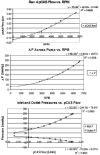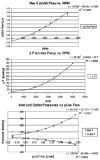In vitro characterization and performance testing of the ension pediatric cardiopulmonary assist system
- PMID: 19293710
- PMCID: PMC2792749
- DOI: 10.1097/MAT.0b013e3181909d76
In vitro characterization and performance testing of the ension pediatric cardiopulmonary assist system
Abstract
In the last 40 years, mechanical circulatory support devices have become an effective option for the treatment of end-stage heart failure in adults. Few possibilities, however, are available for pediatric cardiopulmonary support. Ension Inc. (Pittsburgh, PA) is developing a pediatric cardiopulmonary assist system (pCAS) intended to address the limitations of existing devices used for this patient population. The pCAS device is an integrated unit containing an oxygenator and pump within a single casing, significantly reducing the size and blood-contacting surface area in comparison to current devices. Prototype pCAS devices produce appropriate flows and pressures while minimizing priming volume and preparation time. The pCAS was tested on a mock circulation designed to approximate the hemodynamic parameters of a small infant using a 10-Fr. extracorporeal membrane oxygenation inflow cannula and an 8-Fr. extracorporeal membrane oxygenation outflow cannula. Revision 4 of the device provided a flow rate of 0.42 L/min at 6,500 RPM. Revision 5, featuring improved impeller and diffuser designs, provided a flow rate of 0.57 L/min at 5,000 RPM. The performance tests indicate that for this cannulae combination, the pCAS pump is capable of delivering sufficient flows for patients <5 kg.
Figures





Similar articles
-
Extracorporeal membrane oxygenation versus counterpulsatile, pulsatile, and continuous left ventricular unloading for pediatric mechanical circulatory support.Pediatr Crit Care Med. 2013 Nov;14(9):e424-37. doi: 10.1097/PCC.0b013e3182a551b0. Pediatr Crit Care Med. 2013. PMID: 24108116 Free PMC article.
-
Development of Inspired Therapeutics Pediatric VAD: Benchtop Evaluation of Impeller Performance and Torques for MagLev Motor Design.Cardiovasc Eng Technol. 2022 Apr;13(2):307-317. doi: 10.1007/s13239-021-00578-z. Epub 2021 Sep 13. Cardiovasc Eng Technol. 2022. PMID: 34518953 Free PMC article.
-
Early-stage Development of the CoRISMA Mechanical Circulatory Support (CMCS) System for Heart Failure Therapy.Cardiovasc Eng Technol. 2024 Dec;15(6):667-678. doi: 10.1007/s13239-024-00743-0. Epub 2024 Jul 22. Cardiovasc Eng Technol. 2024. PMID: 39037566
-
Cardiac extracorporeal life support: state of the art in 2007.Cardiol Young. 2007 Sep;17 Suppl 2:104-15. doi: 10.1017/S1047951107001217. Cardiol Young. 2007. PMID: 18039404 Review.
-
Current devices for pediatric extracorporeal life support and mechanical circulatory support systems in the United States.Biomed Mater Eng. 2013;23(1-2):57-62. doi: 10.3233/BME-120732. Biomed Mater Eng. 2013. PMID: 23442237 Review.
Cited by
-
A biohybrid artificial lung prototype with active mixing of endothelialized microporous hollow fibers.Biotechnol Bioeng. 2010 Jun 15;106(3):490-500. doi: 10.1002/bit.22675. Biotechnol Bioeng. 2010. PMID: 20091735 Free PMC article.
-
Thirty-day in-vivo performance of a wearable artificial pump-lung for ambulatory respiratory support.Ann Thorac Surg. 2012 Jan;93(1):274-81. doi: 10.1016/j.athoracsur.2011.08.076. Epub 2011 Nov 25. Ann Thorac Surg. 2012. PMID: 22115337 Free PMC article.
-
Extracorporeal membrane oxygenation versus counterpulsatile, pulsatile, and continuous left ventricular unloading for pediatric mechanical circulatory support.Pediatr Crit Care Med. 2013 Nov;14(9):e424-37. doi: 10.1097/PCC.0b013e3182a551b0. Pediatr Crit Care Med. 2013. PMID: 24108116 Free PMC article.
-
Mock circulatory loop applications for testing cardiovascular assist devices and in vitro studies.Front Physiol. 2023 Apr 13;14:1175919. doi: 10.3389/fphys.2023.1175919. eCollection 2023. Front Physiol. 2023. PMID: 37123281 Free PMC article. Review.
-
A novel wearable pump-lung device: in vitro and acute in vivo study.J Heart Lung Transplant. 2012 Jan;31(1):101-5. doi: 10.1016/j.healun.2011.08.022. Epub 2011 Oct 20. J Heart Lung Transplant. 2012. PMID: 22014451 Free PMC article.
References
-
- Rose, et al. Long term use of Left Ventricular Assist Device for End Stage Heart Failure. New England Journal of Medicine. 2001;345(20):1435–1443. - PubMed
-
- Baldwin JT, Borovetz HS, Duncan VW, Gartner MJ, Jarvik RK, Weiss WJ, Hoke TR. The National Heart Lung and Blood Institute Pediatric Ciruclatory Support Program. Circulation. 2006;113:147–155. - PubMed
-
- Spencer FC, Eisemen B, Trinkle JK, Rossi NP. Assisted Circulation for Cardiac Failure Following Intracardiac Surgery with Cardiopulmonary Bypass. JThoracic.Cardiovasc.Surg. 1965;49:56–73. - PubMed
-
- Cooper DS, Jacobs JP, Moore L, Stock A, Gaynor JW, Chancy T, Parpard M, Griffin DA, Owens T, Checchia PA, Thiagarajan RR, Spray TL, Ravishankar C. Cardiac Extraorpreal Life Support: State of the Art in 2007. Cardiol Young. 2007;17:104–115. - PubMed
-
- Tamblyn J. 5-13-2003. Ref Type: Personal Communication.
Publication types
MeSH terms
Grants and funding
LinkOut - more resources
Full Text Sources

